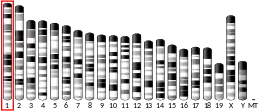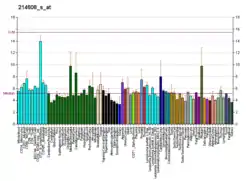EYA1
Eyes absent homolog 1 is a protein that in humans is encoded by the EYA1 gene.[5][6]
This gene encodes a member of the eyes absent (EYA) family of proteins. The encoded protein may play a role in the developing kidney, branchial arches, eye, and ear. Mutations of this gene have been associated with branchiootorenal dysplasia syndrome, branchiootic syndrome, and sporadic cases of congenital cataracts and ocular anterior segment anomalies. A similar protein in mice can act as a transcriptional activator. Four transcript variants encoding three distinct isoforms have been identified for this gene.[6]
References
- GRCh38: Ensembl release 89: ENSG00000104313 - Ensembl, May 2017
- GRCm38: Ensembl release 89: ENSMUSG00000025932 - Ensembl, May 2017
- "Human PubMed Reference:". National Center for Biotechnology Information, U.S. National Library of Medicine.
- "Mouse PubMed Reference:". National Center for Biotechnology Information, U.S. National Library of Medicine.
- Abdelhak S, Kalatzis V, Heilig R, Compain S, Samson D, Vincent C, Weil D, Cruaud C, Sahly I, Leibovici M, Bitner-Glindzicz M, Francis M, Lacombe D, Vigneron J, Charachon R, Boven K, Bedbeder P, Van Regemorter N, Weissenbach J, Petit C (Mar 1997). "A human homologue of the Drosophila eyes absent gene underlies branchio-oto-renal (BOR) syndrome and identifies a novel gene family". Nat Genet. 15 (2): 157–64. doi:10.1038/ng0297-157. PMID 9020840. S2CID 28527865.
- "Entrez Gene: EYA1 eyes absent homolog 1 (Drosophila)".
- Buller, C; Xu X; Marquis V; Schwanke R; Xu P X (Nov 2001). "Molecular effects of Eya1 domain mutations causing organ defects in BOR syndrome". Hum. Mol. Genet. England. 10 (24): 2775–81. doi:10.1093/hmg/10.24.2775. ISSN 0964-6906. PMID 11734542.
Further reading
- Stoppa-Lyonnet D, Carter PE, Meo T, Tosi M (1990). "Clusters of intragenic Alu repeats predispose the human C1 inhibitor locus to deleterious rearrangements". Proc. Natl. Acad. Sci. U.S.A. 87 (4): 1551–5. Bibcode:1990PNAS...87.1551S. doi:10.1073/pnas.87.4.1551. PMC 53513. PMID 2154751.
- Vincent C, Kalatzis V, Abdelhak S, et al. (1998). "BOR and BO syndromes are allelic defects of EYA1". Eur. J. Hum. Genet. 5 (4): 242–6. doi:10.1159/000484770. PMID 9359046.
- Abdelhak S, Kalatzis V, Heilig R, et al. (1998). "Clustering of mutations responsible for branchio-oto-renal (BOR) syndrome in the eyes absent homologous region (eyaHR) of EYA1". Hum. Mol. Genet. 6 (13): 2247–55. doi:10.1093/hmg/6.13.2247. PMID 9361030.
- Pignoni F, Hu B, Zavitz KH, et al. (1998). "The eye-specification proteins So and Eya form a complex and regulate multiple steps in Drosophila eye development". Cell. 91 (7): 881–91. doi:10.1016/S0092-8674(00)80480-8. PMID 9428512. S2CID 269908.
- Kumar S, Kimberling WJ, Weston MD, et al. (1998). "Identification of three novel mutations in human EYA1 protein associated with branchio-oto-renal syndrome". Hum. Mutat. 11 (6): 443–9. doi:10.1002/(SICI)1098-1004(1998)11:6<443::AID-HUMU4>3.0.CO;2-S. PMID 9603436.
- Kalatzis V, Sahly I, El-Amraoui A, Petit C (1999). "Eya1 expression in the developing ear and kidney: towards the understanding of the pathogenesis of Branchio-Oto-Renal (BOR) syndrome". Dev. Dyn. 213 (4): 486–99. doi:10.1002/(SICI)1097-0177(199812)213:4<486::AID-AJA13>3.0.CO;2-L. PMID 9853969.
- Kumar S, Deffenbacher K, Cremers CW, et al. (1999). "Branchio-oto-renal syndrome: identification of novel mutations, molecular characterization, mutation distribution, and prospects for genetic testing". Genet. Test. 1 (4): 243–51. doi:10.1089/gte.1997.1.243. PMID 10464653.
- Ohto H, Kamada S, Tago K, et al. (1999). "Cooperation of six and eya in activation of their target genes through nuclear translocation of Eya". Mol. Cell. Biol. 19 (10): 6815–24. doi:10.1128/mcb.19.10.6815. PMC 84678. PMID 10490620.
- Azuma N, Hirakiyama A, Inoue T, et al. (2000). "Mutations of a human homologue of the Drosophila eyes absent gene (EYA1) detected in patients with congenital cataracts and ocular anterior segment anomalies". Hum. Mol. Genet. 9 (3): 363–6. doi:10.1093/hmg/9.3.363. PMID 10655545.
- Rickard S, Boxer M, Trompeter R, Bitner-Glindzicz M (2000). "Importance of clinical evaluation and molecular testing in the branchio-oto-renal (BOR) syndrome and overlapping phenotypes". J. Med. Genet. 37 (8): 623–7. doi:10.1136/jmg.37.8.623. PMC 1734672. PMID 10991693.
- Rickard S, Parker M, van't Hoff W, et al. (2001). "Oto-facio-cervical (OFC) syndrome is a contiguous gene deletion syndrome involving EYA1: molecular analysis confirms allelism with BOR syndrome and further narrows the Duane syndrome critical region to 1 cM". Hum. Genet. 108 (5): 398–403. doi:10.1007/s004390100495. PMID 11409867. S2CID 8451069.
- Namba A, Abe S, Shinkawa H, et al. (2001). "Genetic features of hearing loss associated with ear anomalies: PDS and EYA1 mutation analysis". J. Hum. Genet. 46 (9): 518–21. doi:10.1007/s100380170033. PMID 11558900.
- Fukuda S, Kuroda T, Chida E, et al. (2002). "A family affected by branchio-oto syndrome with EYA1 mutations". Auris Nasus Larynx. 28 Suppl: S7–11. doi:10.1016/s0385-8146(01)00082-7. PMID 11683347.
- Buller C, Xu X, Marquis V, et al. (2002). "Molecular effects of Eya1 domain mutations causing organ defects in BOR syndrome". Hum. Mol. Genet. 10 (24): 2775–81. doi:10.1093/hmg/10.24.2775. PMID 11734542.
- Ozaki H, Watanabe Y, Ikeda K, Kawakami K (2002). "Impaired interactions between mouse Eyal harboring mutations found in patients with branchio-oto-renal syndrome and Six, Dach, and G proteins". J. Hum. Genet. 47 (3): 107–16. doi:10.1007/s100380200011. PMID 11950062.
- Xu PX, Zheng W, Laclef C, et al. (2002). "Eya1 is required for the morphogenesis of mammalian thymus, parathyroid and thyroid". Development. 129 (13): 3033–44. PMC 3873877. PMID 12070080.
- Vervoort VS, Smith RJ, O'Brien J, et al. (2003). "Genomic rearrangements of EYA1 account for a large fraction of families with BOR syndrome". Eur. J. Hum. Genet. 10 (11): 757–66. doi:10.1038/sj.ejhg.5200877. PMID 12404110.
- Fougerousse F, Durand M, Lopez S, et al. (2003). "Six and Eya expression during human somitogenesis and MyoD gene family activation". J. Muscle Res. Cell. Motil. 23 (3): 255–64. doi:10.1023/A:1020990825644. PMID 12500905. S2CID 42497614.
- Yashima T, Noguchi Y, Ishikawa K, et al. (2003). "Mutation of the EYA1 gene in patients with branchio-oto syndrome". Acta Otolaryngol. 123 (2): 279–82. doi:10.1080/0036554021000028103. PMID 12701758. S2CID 24399383.
This article is issued from Wikipedia. The text is licensed under Creative Commons - Attribution - Sharealike. Additional terms may apply for the media files.




